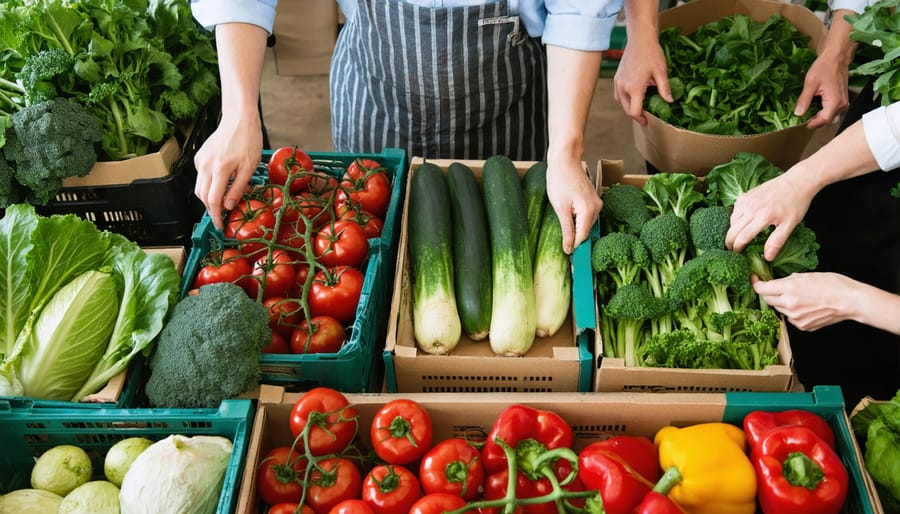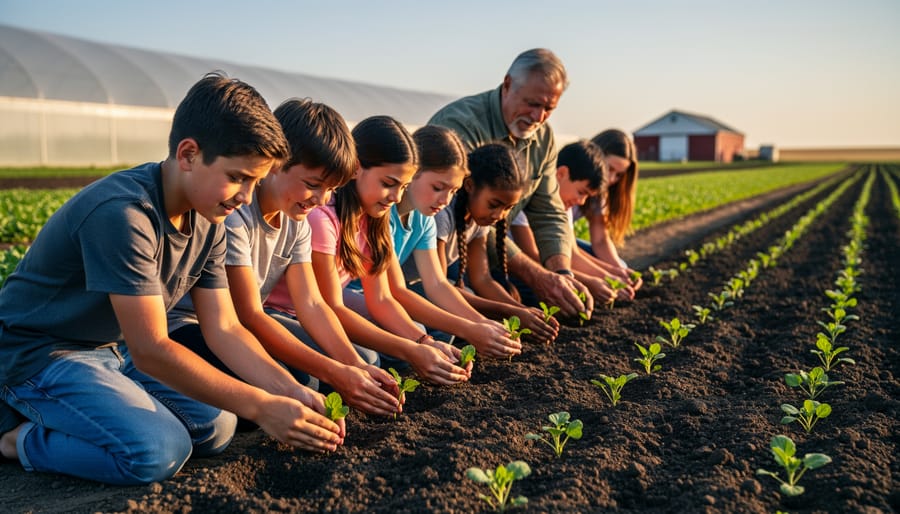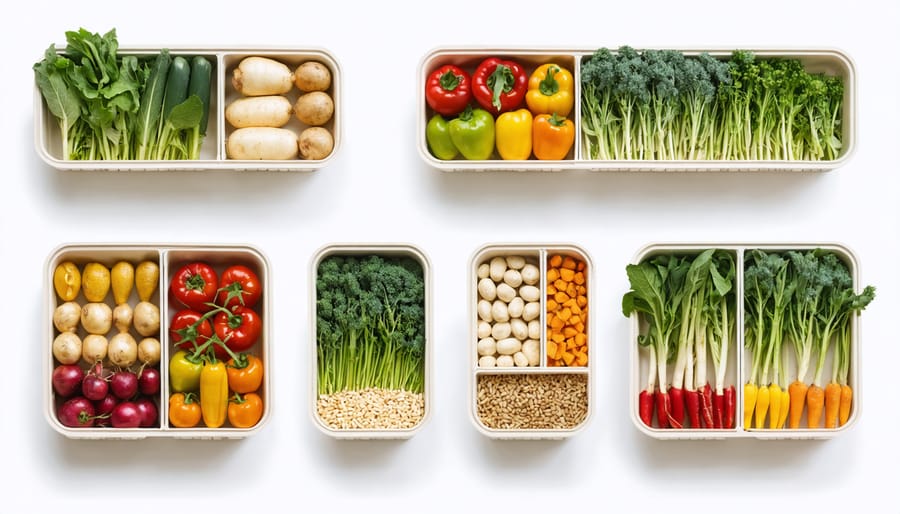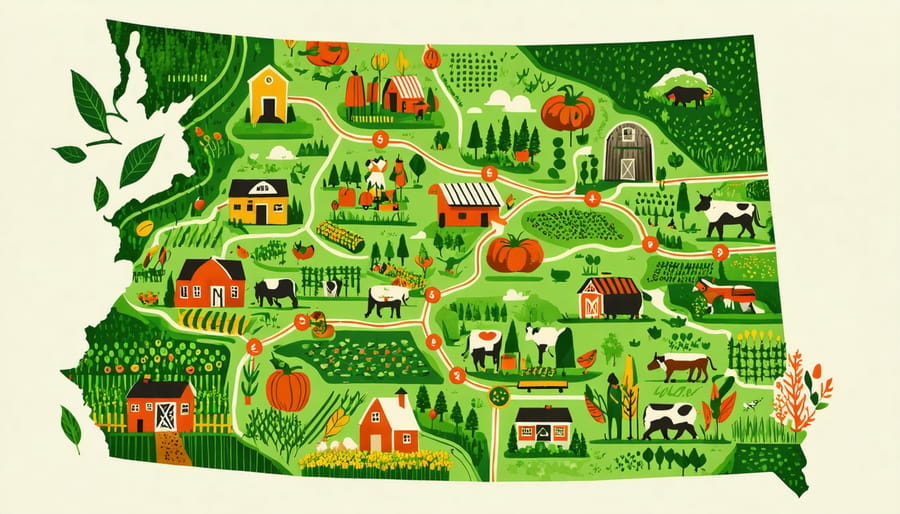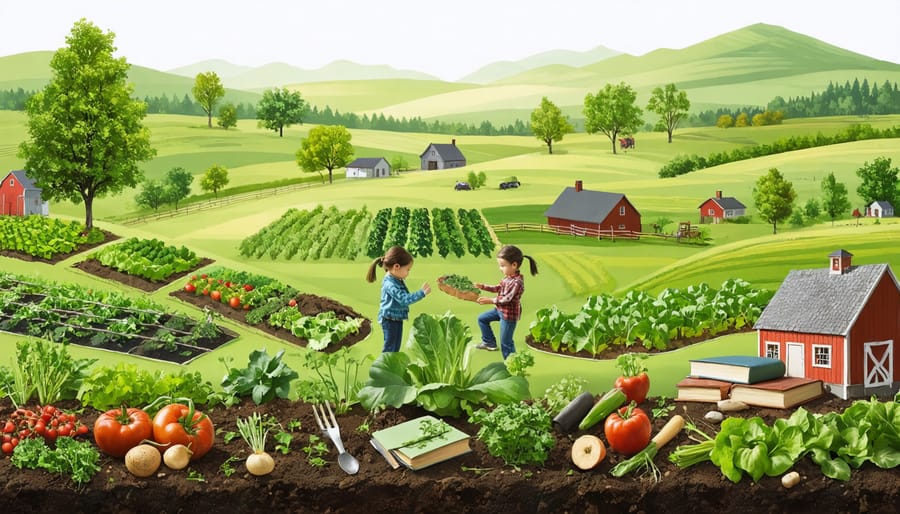Fresh, local produce is revolutionizing Alberta’s food landscape, connecting farmers directly with consumers through innovative distribution networks that cut delivery times from days to hours. Modern farm-to-table systems have evolved beyond simple farmers’ markets, now incorporating advanced cold-chain technology, real-time inventory tracking, and sustainable packaging solutions that maintain produce freshness while reducing environmental impact.
For Alberta’s agricultural community, this shift represents both an opportunity and a challenge: meeting growing consumer demand for ultra-fresh produce while adapting traditional farming practices to support rapid-delivery systems. Regional success stories, like the Red Deer Valley Collaborative, demonstrate how local farmers are achieving 98% delivery efficiency while reducing food waste by 40% through smart logistics and community partnerships.
The farm-to-table movement has matured into a sophisticated ecosystem where technology meets tradition, enabling farmers to maintain crop integrity from field to plate while maximizing profitability. This direct-to-consumer approach not only ensures peak nutritional value but also strengthens local food security and supports sustainable agricultural practices across the province.
Smart Packaging Solutions Transforming Local Produce Distribution
Biodegradable Packaging Materials
In Alberta’s evolving farm-to-table landscape, environmentally conscious packaging solutions are becoming increasingly important for both farmers and consumers. Several local producers have successfully transitioned to biodegradable materials that maintain produce freshness while reducing environmental impact.
Popular eco-friendly options include compostable bags made from corn starch, which break down completely within 180 days in commercial composting facilities. These materials offer excellent moisture resistance while remaining breathable, making them ideal for leafy greens and root vegetables.
Mushroom packaging, developed using agricultural waste and mycelium, has gained traction among Alberta farmers for protecting delicate produce like tomatoes and berries. This innovative material decomposes in home gardens, adding nutrients to the soil.
Paper-based solutions, including recycled cardboard boxes and molded pulp trays, remain reliable choices for bulk packaging. Many local producers are partnering with Alberta-based packaging manufacturers who source materials from sustainably managed forests within the province.
For smaller operations, reusable options like returnable wooden crates and cloth bags have proven successful, especially when implementing deposit systems. These solutions not only eliminate waste but also help build customer loyalty through sustainability programs.
When selecting packaging materials, consider factors like seasonal temperature variations, transportation distance, and product requirements. Local agricultural extension offices can provide guidance on suppliers and cost-effective implementation strategies that align with both environmental goals and business needs.
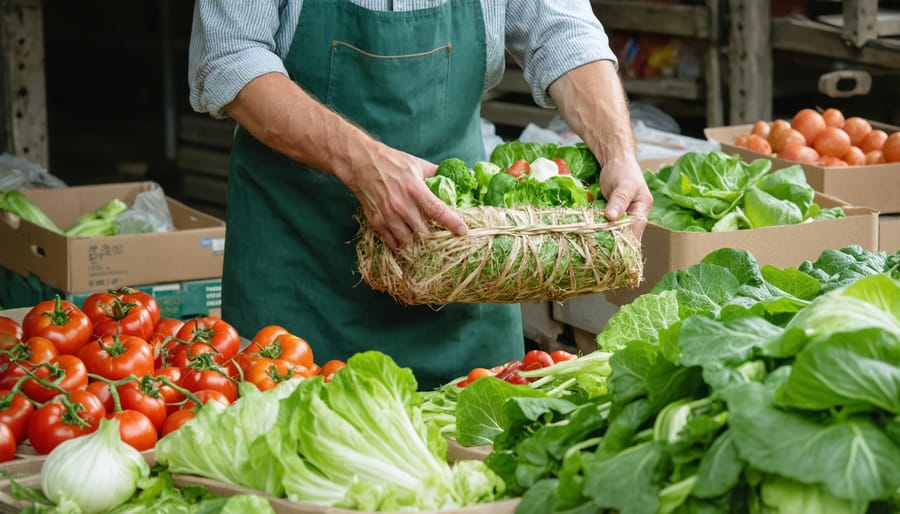
Temperature-Controlled Solutions
Modern cold chain management has revolutionized how we maintain produce freshness from farm to table. Here in Alberta, farmers are implementing sophisticated temperature monitoring systems that track and maintain optimal conditions throughout the entire distribution journey.
Smart sensors now allow us to maintain precise temperature zones for different types of produce. Leafy greens stay crisp at 0-4°C, while tomatoes and cucumbers require slightly warmer conditions around 7-10°C. These customized environments help extend shelf life while preserving nutritional value and taste.
Local success stories include the Red Deer Valley Cooperative, which reduced produce loss by 30% after implementing IoT-enabled temperature monitoring. Their system sends real-time alerts if temperatures fluctuate beyond acceptable ranges, allowing for immediate corrective action.
Innovative packaging solutions also play a crucial role. Phase-change materials integrated into shipping containers help maintain steady temperatures, while ethylene-absorbing technologies prevent premature ripening during transport. These advances are particularly valuable for our prairie farmers shipping to urban markets across provinces.
For small-scale operations, cost-effective solutions like properly insulated transport bins and mobile cooling units can make a significant difference. Many Alberta farmers have found success using hybrid systems that combine traditional cold storage with modern monitoring technology, proving that temperature control doesn’t always require massive investment.
Remember, consistent temperature management isn’t just about preventing spoilage – it’s about delivering the premium quality our customers expect while maximizing your operation’s efficiency and sustainability.
Local Distribution Networks That Work
Community-Supported Agriculture (CSA) Distribution
Alberta’s Community-Supported Agriculture programs have shown remarkable success in recent years, with notable examples like Whispering Meadows Farm and Prairie Bounty Organics leading the way. These farms have developed innovative distribution models that benefit both producers and consumers while strengthening local food systems.
The Whispering Meadows Farm CSA, located near Red Deer, serves over 200 member families through a flexible share system. Members can choose between weekly or bi-weekly deliveries, with customizable box sizes ranging from 5 kg to 15 kg of seasonal produce. Their success lies in their hybrid distribution approach, combining centralized pickup locations in urban centers with home delivery options within a 50 km radius.
Prairie Bounty Organics, operating near Lethbridge, has pioneered a year-round CSA model by incorporating greenhouse production and root cellar storage. Their 150-member program offers extended seasonal access to fresh produce, with 90% member retention rate year over year. They’ve implemented an online ordering system that allows members to swap items based on preferences while maintaining the program’s community-focused nature.
Key factors contributing to these successful models include:
– Transparent communication about growing practices and harvest schedules
– Flexible payment options, including monthly installments
– Regular farm visits and educational workshops for members
– Partnership with other local producers to diversify offerings
– Implementation of efficient cold chain management systems
Direct-to-Restaurant Supply Chains
Direct partnerships between farmers and restaurants have revolutionized the way local produce reaches dining tables across Alberta. These restaurant partnerships eliminate multiple intermediaries, ensuring fresher products and better profit margins for both parties.
Successful farm-to-restaurant distribution often relies on establishing clear communication channels and delivery schedules. Many Alberta farmers have found success by implementing flexible delivery systems that accommodate both early morning and late evening drop-offs, working around restaurant peak hours. This approach has proven particularly effective for time-sensitive items like leafy greens and berries.
Local farmers are increasingly using temperature-controlled vehicles and specialized packaging to maintain produce quality during transport. Some have invested in reusable containers and sustainable packaging solutions, which not only protect the produce but also align with restaurants’ environmental values.
Digital ordering systems have streamlined the process, with many farmers using apps or online platforms to manage orders and inventory. These tools allow chefs to place orders up to 48 hours in advance, giving farmers time to harvest at peak freshness.
Regular face-to-face meetings between farmers and chefs have proven invaluable, allowing both parties to plan seasonal menus and discuss crop varieties that best suit the restaurant’s needs. This collaborative approach has led to more stable pricing structures and year-round partnerships, particularly beneficial during Alberta’s shorter growing season.
Digital Platforms Connecting Farms to Tables
Digital platforms are revolutionizing how Alberta farmers connect with local consumers, restaurants, and retailers. These innovative solutions streamline the distribution process, making it easier than ever to bring fresh, local produce directly to tables across the province.
Popular platforms like Local Line and Open Food Network enable farmers to showcase their products, manage inventory, and process orders efficiently. These systems allow customers to browse available produce, place orders, and arrange pickup or delivery – all through user-friendly interfaces that work on smartphones and computers.
The Alberta-based platform Farm2Table, developed by local tech entrepreneurs, has gained significant traction among small-scale farmers. Sarah Thompson, who runs Rainbow Creek Farm near Red Deer, shares, “Since adopting the platform, we’ve increased our direct sales by 40% and significantly reduced time spent on order management.”
Many of these platforms also offer features like automated invoicing, delivery route optimization, and real-time inventory updates. Some even integrate with existing accounting software, making it easier for farmers to manage their business operations.
For community-supported agriculture (CSA) programs, specialized software helps manage member subscriptions, communicate with customers, and coordinate weekly deliveries. These tools have proven particularly valuable during peak harvest seasons when time management is crucial.
The adoption of these digital solutions has helped create resilient local food systems while reducing food miles and supporting regional agriculture. As technology continues to evolve, these platforms are becoming increasingly essential tools for modern farm-to-table operations.
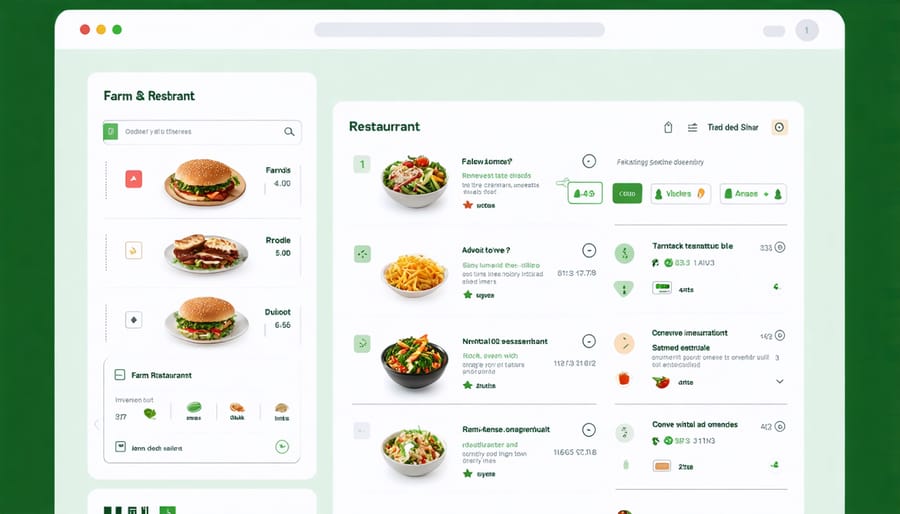
Environmental Impact and Cost Analysis
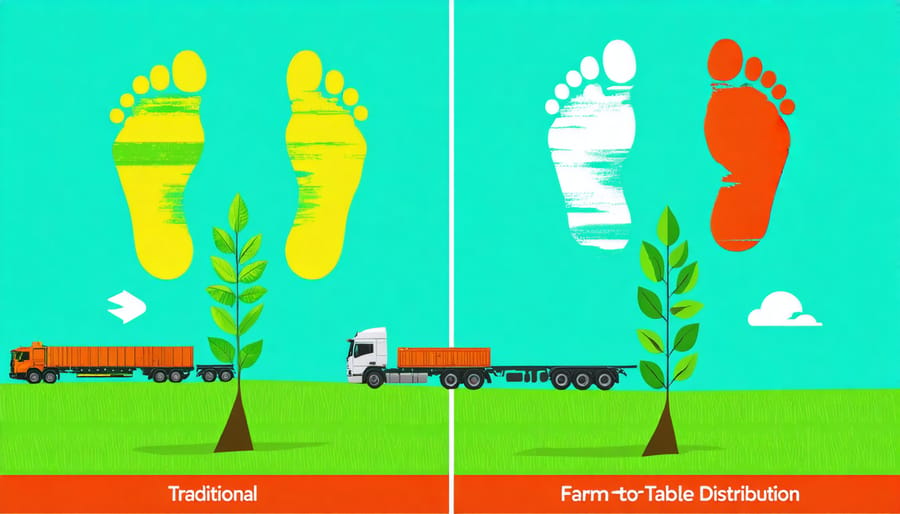
Carbon Footprint Reduction
Farm-to-table operations in Alberta are significantly reducing their carbon footprint through innovative packaging and distribution strategies. Recent studies from the University of Alberta show that local food distribution systems can reduce transportation emissions by up to 75% compared to conventional supply chains.
Many Alberta farmers have adopted reusable packaging solutions, such as sturdy plastic bins and wooden crates, which can be sanitized and reused hundreds of times. This practice alone has helped reduce packaging waste by an estimated 40% across participating farms. The Lethbridge Food Hub, for example, implemented a bin-sharing program that eliminated over 12,000 single-use boxes annually.
Smart route planning and consolidated deliveries are making a substantial impact. Calgary-area producers are using cooperative distribution networks, where multiple farms share delivery vehicles and coordinate drop-off points. This approach has cut delivery-related emissions by approximately 30% while maintaining produce freshness.
Cold chain optimization plays a crucial role too. Modern energy-efficient cooling systems and properly insulated transport containers help maintain optimal temperature with minimal energy consumption. Several Red Deer region farms have reported 25% lower energy costs after upgrading their cold storage facilities.
These improvements aren’t just environmental wins – they’re proving economically beneficial. Farmers report average cost savings of $2.50 per box through reusable packaging systems, while consolidated distribution networks are reducing fuel costs by up to 35% per delivery route.
Economic Benefits for Alberta Farmers
Alberta farmers implementing sustainable farm-to-table distribution systems are discovering significant financial advantages while strengthening their local economies. Recent studies show that direct-to-consumer sales can increase profit margins by 40-80% compared to traditional wholesale channels, providing immediate economic benefits for rural communities.
The initial investment in sustainable distribution infrastructure typically ranges from $5,000 to $25,000, depending on scale and existing facilities. However, farmers report recovering these costs within 2-3 growing seasons through reduced transportation expenses and higher retail prices. Local distribution networks eliminate multiple middlemen, allowing farmers to retain up to 80% of the food dollar compared to just 17% in conventional supply chains.
Cost-saving measures include shared cold storage facilities, cooperative delivery routes, and collective marketing efforts. Farmers participating in local food hubs report annual savings of $8,000-$12,000 in logistics costs alone. Additionally, reduced food waste through shorter supply chains saves an average of 15% in product loss, translating to approximately $7,500 annually for mid-sized operations.
Digital platforms for direct sales and inventory management, while requiring an initial investment of $1,000-$3,000, reduce administrative costs by 30% and improve customer relationship management. Many Alberta farmers have found success by combining traditional farmers’ markets with modern e-commerce solutions, creating resilient revenue streams that weather market fluctuations.
Implementation Guidelines for Farmers
To successfully implement a farm-to-table program, start by assessing your current operations and identifying potential direct-market opportunities in your area. Begin with a small-scale pilot project, focusing on 2-3 key crops that are in high demand among local restaurants and markets.
Establish clear food safety protocols that meet or exceed Canadian Food Inspection Agency (CFIA) standards. Implement a comprehensive tracking system to monitor produce from seeding to harvest, including detailed records of planting dates, fertilizer applications, and harvest times. This documentation is crucial for building trust with buyers and maintaining compliance.
Invest in proper post-harvest handling equipment, including washing stations and cooling facilities. For Alberta farmers, consider cold storage solutions that can handle temperature fluctuations between -40°C and +30°C throughout the year. A walk-in cooler of at least 10 square metres is recommended for small to medium operations.
Develop strong relationships with local chefs and retailers by:
– Providing regular updates on crop availability
– Offering samples of new varieties
– Maintaining consistent delivery schedules
– Being responsive to feedback and special requests
Consider packaging innovations that extend shelf life while minimizing environmental impact. Recyclable plastic crates or reusable bins work well for local deliveries within a 100-kilometre radius. For longer distances, invest in temperature-controlled packaging that maintains freshness for up to 48 hours.
Plan your crop rotation and succession planting to ensure consistent supply throughout the growing season. In Alberta’s climate, this typically means starting seedlings indoors 6-8 weeks before the last frost date and utilizing season extension techniques like row covers and high tunnels.
Join local farming networks and attend agricultural workshops to stay current with best practices and connect with potential buyers. The Alberta Farm Fresh Producers Association offers valuable resources and networking opportunities for direct-market farmers.
Remember to start small, document everything, and gradually scale up as you build reliable partnerships and streamline your operations. Success in farm-to-table distribution comes from maintaining high quality standards while adapting to meet customer needs.
Farm-to-table distribution in Alberta continues to evolve, driven by growing consumer demand for fresh, locally sourced produce and innovative farming practices. The future looks promising, with more farmers adopting sustainable packaging solutions and leveraging digital platforms to connect directly with consumers and restaurants. Success stories from local producers demonstrate that building strong community relationships and maintaining transparent supply chains are key to thriving in this sector.
Looking ahead, we can expect to see increased investment in cold chain technology, expanded regional distribution networks, and greater collaboration among producers. The implementation of smart farming techniques and data-driven decision-making will help optimize production and delivery schedules. As Alberta’s agricultural community continues to embrace these innovations, the farm-to-table movement is positioned to become an even more integral part of our province’s food system, benefiting both producers and consumers while supporting environmental sustainability.

